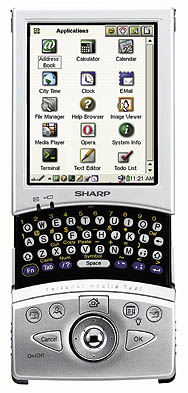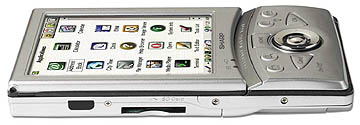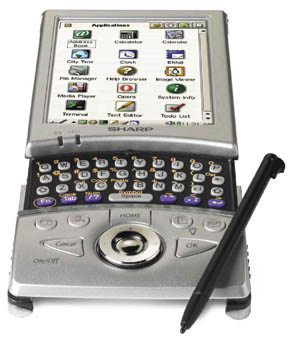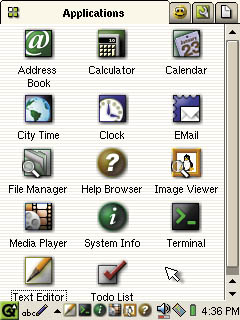|
|
|
Return of the ZaurusThe handheld leader in Japan, Sharp takes another shot at the US market with the spectacular SL-5000
December 10, 2001 --
When Sharp pulled the relatively unsuccessful Zaurus out of the US market, we
waited a respectful amount of time and then cancelled our column and other
coverage of the platform. Apparently intimidated by the aggressive stance taken
by Microsoft with their new Windows CE-based Handheld PC, combined with Palm's
success with what was then called the PalmPilot, Sharp executives must have
figured it wasn't worth fighting for the number three position. Psion's Series 5
was selling in those days, a mini-clamshell design that was very similar to the
Zaurus, so they would have been faced with sharing the few remaining percentage
points of marketshare with the Brits as well.
The story across the Pacific was entirely different. Sharp dominated the handheld
market consistently, with regular upgrades of existing models and exciting new
units featuring the latest technology. But with success of Microsoft's Pocket PC
platform, it was looking like coming back to the States would be ill advised.
The first of these new Zaurii, the SL-5000D, was built in limited quantities and
is sold only to developers. I was able to procure one of these units for the
purposes of writing this preview, and I must say that I am very much inclined to
think Sharp has a true winner on its hands.
When it arrives, the new unit will have double the memory
of its trial balloon predecessor, a generous 64MB. The 5500 will be identical to
the 5000 on the outside, but on the inside will reside updated OS, driver, and
application software packed into the device's 16MB of flash ROM.
You'd think that a mere handheld stuffed full of Linux would be dog-slow, but in
this case you'd be wrong. The SL sports a mighty Intel StrongARM running at
206Mhz, so the performance is on a par with all the new Pocket PC 2002 models
from Compaq, HP, NEC, and Toshiba. Sharp chose Lineo's Embedix Linux kernel is
optimizing it for speed on a small device. Trolltech's Qtopia windowing interface
and PIM suite are as beautiful as they are functional, and it syncs with desktop
PIM s, too. There is a full-featured web browser from Opera, a robust email
client and advanced Java VM support from Insignia Solutions. There is even a
powerful media player supporting MPEG movies and music streams.
Also noteworthy is the new Z's dual flash slots: a CFII on top and an SD on the
left side. It's just as well they did this since you'll undoubtedly want to use
the CF slot for a wireless card, leaving the SD for backup and such.
We'll go deeper into Sharp's new Zaurus in the next issue of Pen Computing with a
full PenLab review, along with hardware and accessory reviews as new products are
released. For now, it's just nice to know that the increasingly tedious Palm
versus Pocket PC battle finally has a formidable new combatant.
Sharp: www.sharp-usa.com and http://developer.sharpsec.com
|
|
|
[Homepage] All contents ©1995-2001 Pen Computing Magazine, Inc. All rights reserved. |
 Every time Sharp Corporation came out with some hot new Zaurus for the Japanese
home market, the editors of Pen Computing would howl, "It's gorgeous, but why
can't we have a US version?" Cool features like reflective color TFT displays and
wireless connections often show up first on the latest Zaurus, but we could only
see them at international tradeshows or in Japanese magazines, and they all had
touchscreens. Frustrating.
Every time Sharp Corporation came out with some hot new Zaurus for the Japanese
home market, the editors of Pen Computing would howl, "It's gorgeous, but why
can't we have a US version?" Cool features like reflective color TFT displays and
wireless connections often show up first on the latest Zaurus, but we could only
see them at international tradeshows or in Japanese magazines, and they all had
touchscreens. Frustrating.  Then a miracle happened in the shape of a penguin. Sharp could take all they had
learned about building state-of-the-art handheld computers and combine it with
the license-free, open source Linux operating system, building a market niche for
themselves that was theoretically unassailable. Early Linux-based handhelds have
been resounding duds, so there was nowhere to go but up. If Sharp could partner
up with the very best developers in the Linux environment, then back it up with
some IT credibility by hooking up with a well-established middleware player to
sew all the wireless communications together, the plan could work.
Then a miracle happened in the shape of a penguin. Sharp could take all they had
learned about building state-of-the-art handheld computers and combine it with
the license-free, open source Linux operating system, building a market niche for
themselves that was theoretically unassailable. Early Linux-based handhelds have
been resounding duds, so there was nowhere to go but up. If Sharp could partner
up with the very best developers in the Linux environment, then back it up with
some IT credibility by hooking up with a well-established middleware player to
sew all the wireless communications together, the plan could work.  And then we have the defining characteristic of
the new Zaurus, the slide-out keyboard. Anyone who has used a RIM Blackberry or a
Handspring Treo will be right at home on this keyboard, which is designed to be
used with your thumbs. It's an acquired taste, these little keyboards, but many
people find them easier to use than handwriting recognition. The new Zaurus does
include a serviceable, Graffiti-like recognizer that can be customized to your
writing style.
And then we have the defining characteristic of
the new Zaurus, the slide-out keyboard. Anyone who has used a RIM Blackberry or a
Handspring Treo will be right at home on this keyboard, which is designed to be
used with your thumbs. It's an acquired taste, these little keyboards, but many
people find them easier to use than handwriting recognition. The new Zaurus does
include a serviceable, Graffiti-like recognizer that can be customized to your
writing style.  All this promising functionality would be fairly pointless if you couldn't see
it, so Sharp equipped the new Z with its excellent reflective color TFT display,
with 320x240 pixels showing 64,000 colors. Hold it up to any of the new Pocket
PCs and you'll see a brighter display with better contrast, truer whites, and
none of the reddish cast of the other displays. In a word, it's gorgeous.
All this promising functionality would be fairly pointless if you couldn't see
it, so Sharp equipped the new Z with its excellent reflective color TFT display,
with 320x240 pixels showing 64,000 colors. Hold it up to any of the new Pocket
PCs and you'll see a brighter display with better contrast, truer whites, and
none of the reddish cast of the other displays. In a word, it's gorgeous.